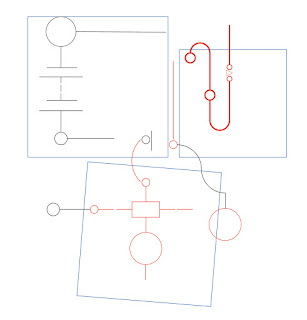Brain Pathways | Electrical Circuit Diagrams = Brain Modular Type
Read and View our Brain Circulations:

1. Brain Touch (Sensory) Pathway:
- Dorsal Column - Medial Lemniscus Pathway or Touch (Sensory) Pathway which gives the ability of touch.
- Why it DC? It is for the dorsal column of the spinal cord.
- Why ML? It is for the Medial Lemniscus in the brainstem.
- It transmit the information from the body to the somatosensory cortex. It is the pathway that receives information from the sensory receptors through the body.
- The first order of neurons (left ground) - sensory neurons (dorsal root ganglia) makes contact with the second order of neurons (right ground) - gracile nucleus (dorsal cuneate nucleus in medulla).
- The pathway it starts from the first order of neurons and goes to the midbrain through the second order of neurons from there travels to the third order of neurons at the thalamus.
2. Brain Vision Pathway:
- What is it? It is the trip from the optic nerves to optic chiasm and from there to optic tracts, lateral geniculate bodies, optic radiations, and visual cortex.
- What cells send information to the brain? Ganglion cells in the retina send information to the brain.
- Light? Electrochemical impulses travel to the optic nerves and the to the brain.
- What is the pathway? Visual sensations transform the information and they send it to the retina of the brain. The nerve fibers, carry the visual sensations to the retina and the to the optic nerve.
- The photoreceptor converts the light energy into a neural signal. Following the process the bipolar cell and the amacrine cell and then to the ganglion cell.
3. Brain Hearing (auditory) Pathway:
- It is the soundscape trip from brain to ears and back. Sounds travel from around to the ear canal and then to the eardrum.
- Then, it vibrates and the vibrations transform to sounds were they travel through ossicles to the cochlea.
- Cochlea sounds travel as ocean waves. The movement touches the hair cells, where the auditory nerves pick up any neural signals. The one end hair cells pick up low pitch sounds and on the other end pick up high pitch sounds.
- Then auditory nerve moves signals to the brain, and there it is where the sounds start making meaning to meaningful and familiar process. It is the brain that "hears" and not the ears.
4. Brain Smell (olfactory) Pathway:
- Smell is Olfactory system\ pathway - slender nerve cells are in a large number (around 100 million) in the epithelium.
- What is epithelium? Visualise it as the power transformer from the electrical symbols as it is shown in the diagram below.
- Each olfactory receptor (voltage regulators) emits the process.
- Gustatory pathway is part of the brain circuit. What is Gustatory? It is the taste and below in the diagram is the pathway of taste to the brain.
- Taste starts from Cranial Nerve X (ground), Cranial Nerves VII, IX (dc supply) and Rostral Division (antenna).
- Parabrachial Nucleus (transformer) leads to the Insular Cortex (it starts from the two switches and travels all the way until the contract circuit breaker).
- Last part is the Ventral Posteromedial Thalamus (battery).

Comments
Post a Comment